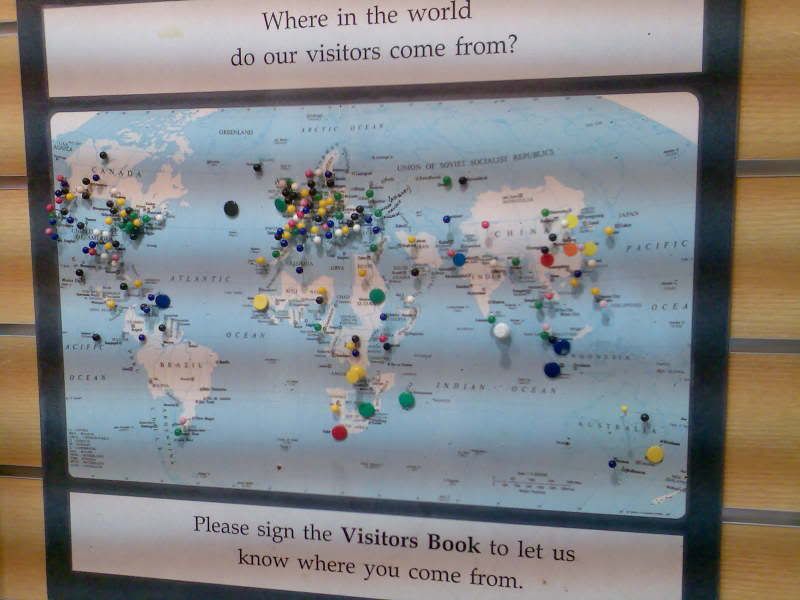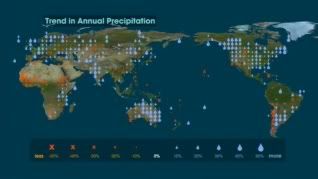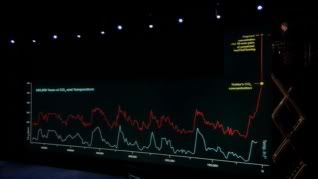
20 Mar 2009
Data Representation
Hows this for a visual representation of data? Found in the Wrexham Tourist Information Centre, people are invited to place a pin on this map to indicate where they are from. The result is.....well its a map with pins attached in different places, but over time this begins to show patterns and trends in the origins of the visitors to Wrexham.


19 Mar 2009
An Inconvenient Truth

A film that is; its fair to say, of the moment. A film that touches on a delicate political as well as moral issue - the state of our environment and our seemingly catastrophic effect on it, also known as global warming...
But we're not interested in that, we're far more interested in the charts, graphs, illustrations, motion graphics, and even 3D animations used in Al Gore's presentation...obviously.
That might sound daft but there is a method to the seemingly apparent madness; as this film shows not only that data/information does not need to always be shown in the everyday forms we are all accustomed to, but that it is in the variety of the presentation that really gets the point across to your audience. In the film Gore uses a number of methods, (conventional and less so) to illustrate the points made and I think it is this variety that keeps audience's attention and prevents the presentation from stagnating and the audience 'losing the plot'.
Below are a few stills from the film...



Overall an excellent film, which really hits home, primarily if not wholly due to the methods of data presentation and the way in which the message is communicated.
10 Mar 2009
Andreas Gursky
 |  |
Through research for the Data Collection and Information brief I have come across the work of German photographer Andreas Gursky; known for his truely large scale prints - some of which measure 6x10ft and more!
The sheer scale of such works is impressive yet this only works if the content is there. With Gursky's work this seems to be the case. By standing back, and observing a given scene/scenario as an external observer looking in, Gursky's captures appear somewhat distant and emotionless. Where works such as David Bailey employed techniques such as cropping to the point of removing a subject's limbs in order to achieve a resonating emotional connection between the image and the audience; Andreas Gursky has a somewhat reverse approach. His recording of the scene allows the audience/viewer to step back and detach themselves from the image and to an extent perhaps limiting or at least reasoning the audience's interpretation by removing the emotional connection.
I suppose the magical element to Gursky's work does lie in the scale, as the images presented are photographs they retain the innate habit of photographs which is their high level of detail.

3 Mar 2009
Fallon
The latest in the series of ads for a brand that suffice to say, (and on the face of it may appear they agree) don't need to take their advertising campaign all too seriously.
Produced by the London 'branch' of the American design agency Fallon, Fallon London are known for many memorable ad-campaigns such as "bring on the trumpets" which in itself has spawned a devoted fanbase. However they are perhaps most well known as the creators of the Cadbury series of ads. Notably featuring toy models of airport vehicles, a talented gorilla, and most recently a pair of kids with an unusual skill, (or so it would seem if it wasn't for post-production).
The latest of these ads, (as seen above) needs no introduction, (like the brand it represents ironically) follows in the tradition of the series yet only having looked at it, (and it predecessors) closely have I noticed just how well put together these ads really are.
For instance, it would appear on the surface to have no relation to the brand whatsoever, however Fallon have placed subtle keys within the visuals. Such as the purple boards in the "gorilla" spot, and the purple clothing worn by the young girl in the "eyebrows" spot which are direct links to the colour scheme of the brand.
Also, as a whole, the ads may seem to be completely unrelated in terms of topic, and compared to one another this may well be the case. Yet the smallest amount of research into the nature of the product(s) these ads represent and the effects on the human body will show that chocolate forces the production of something called endorphines or 'the happy chemical'. I think it is this effect that the ads are intended to create/simulate so to speak. That is the ads are intended to be a sort of 'visual chocolate' if you like, to raise a smile.
With all the hype surrounding these adverts, it looks like Fallon succeeded...
Subscribe to:
Comments (Atom)



